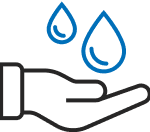FAQ on AWWA LCRI Petition

Lead Petition FAQ
American Water Works Association Lead and Copper Rule Improvements Petition FAQ
Why did the American Water Works Association (AWWA) file a petition for judicial review of the Lead and Copper Rule Improvements (LCRI)?
AWWA is filing a petition for judicial review regarding our concerns over several elements of the rule, including:
- The LCRI’s presumption that if a water system can access a lead service line on private property, the water system has “control” over that line. Under the Safe Drinking Water Act, access does not equal control.
- The feasibility of replacing all lead service lines (and galvanized service lines requiring replacement) within 10 years of the compliance deadline, Nov. 1, 2027.
- AWWA’s concerns about the impact of the LCRI on water affordability, particularly for households that struggle to pay for essential needs. Water systems are already actively identifying and replacing lead service lines, and their real-world experience tells us that the true costs of replacement are far higher than the U.S. Environmental Protection Agency’s estimates.
A detailed discussion of AWWA’s LCRI concerns is available in formal comments submitted in February 2024 on the LCRI proposal.
Does AWWA support the replacement of lead service lines?
Absolutely. AWWA is a strong advocate for the protection of water consumers as we strive for a future where lead is no longer in contact with drinking water. AWWA supports the complete replacement of lead service lines nationwide within the quickest feasible timeframe. It’s important to note that in fact, AWWA intervened in court to support the previous (2021) Lead and Copper Rule Revisions (LCRR) rule, defending its requirement for development and implementation of complete lead service line replacement strategies.
We will continue to share success stories from our members about overcoming barriers to LSL replacement, improving corrosion control practices, collaborating with community partners, and communicating about lead with clarity and transparency.
Why is AWWA concerned about who “controls” lines on private property?
The rule requires water systems to replace lead service lines (and galvanized lines requiring replacement under the rule) when the water system controls those lines. The LCRI presumes that a water system “controls” a lead service line when it has “access” to that line. Under the Safe Drinking Water Act, access does not equal control. By attempting to define access and control as one and the same, the LCRI effectively expands the definition of a public water system to include private property and makes water systems responsible for issues on private property they cannot necessarily address. This interpretation sets a precedent that deserves careful examination.
What is the concern about EPA’s 10-year timeframe for lead service line replacement nationwide?
Complete, nationwide lead service line replacement is an achievable goal. However, the LCRI’s requirement to replace all lead service lines (and galvanized lines requiring replacement) by 2037 is not realistic. The timeline for replacement must recognize local circumstances and encourage shared responsibility among water systems, customers, government, and other stakeholders.
It bears repeating: AWWA strongly supports EPA’s objective to replace every lead service line – regardless of what regulation is in effect. AWWA intervened in court to support the previous (2021) LCRR rule, defending its requirement for development and implementation of complete lead service line replacement strategies. However, under the LCRI, many communities will face significant financial, logistical and personnel challenges and will be unable to meet EPA’s timeline for replacement.
How does the LCRI impact affordability?
AWWA is concerned about the impact of the final rule on water affordability, particularly for households that struggle to pay for essential needs. Water systems are already actively identifying and replacing lead service lines, and their real-world experience tells us that the costs of replacement are far higher than EPA’s estimates. An AWWA-sponsored study shows the actual cost of replacing each lead service line could average more than $12,000, and EPA estimates there are approximately 9.2 million lead service lines nationwide. That means the aggregate cost of replacement could exceed $100 billion. Ultimately, these costs will be reflected in higher water bills, impacting affordability for many households.
How has the Lead and Copper Rule improved public health over time?
Implementation of the Lead and Copper Rule over the past 25 years has resulted in major improvements in public health; the number of the nation’s largest drinking water systems with a 90th percentile sample value exceeding the LCR action level of 15 parts per billion has decreased by over 90 percent since the initial implementation of the LCR. An EPA white paper in 2016 on the LCR revisions states that median blood levels for young children have decreased 10-fold since the mid-1970s.

